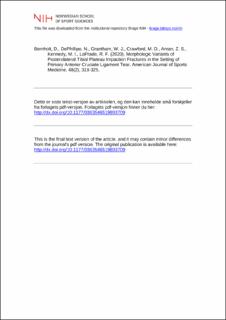| dc.contributor.author | Bernholt, David | |
| dc.contributor.author | DePhillipo, Nicholas | |
| dc.contributor.author | Grantham, W. Jeffrey | |
| dc.contributor.author | Crawford, Matthew D. | |
| dc.contributor.author | Aman, Zachary S. | |
| dc.contributor.author | Kennedy, Mitchell I. | |
| dc.contributor.author | LaPrade, Robert F. | |
| dc.date.accessioned | 2020-10-14T12:34:14Z | |
| dc.date.available | 2020-10-14T12:34:14Z | |
| dc.date.created | 2020-08-13T10:37:51Z | |
| dc.date.issued | 2020 | |
| dc.identifier.citation | American Journal of Sports Medicine. 2020, 48(2), 318-325. | en_US |
| dc.identifier.issn | 0363-5465 | |
| dc.identifier.uri | https://hdl.handle.net/11250/2682840 | |
| dc.description | I Brage finner du siste tekst-versjon av artikkelen, og den kan inneholde ubetydelige forskjeller fra forlagets pdf-versjon. Forlagets pdf-versjon finner du på journals.sagepub.com / In Brage you'll find the final text version of the article, and it may contain insignificant differences from the journal's pdf version. The definitive version is available at journals.sagepub.com | en_US |
| dc.description.abstract | Background: Impaction fractures of the posterolateral tibial plateau commonly occur in the setting of anterior cruciate ligament (ACL) tears, with considerable variability found in fracture size and morphologic features. Purpose: The primary objective was to characterize different morphologic variants of posterolateral tibial plateau impaction fractures. The secondary objective was to investigate the association between these impaction fracture variants and concomitant meniscal and ligamentous injuries. Study Design: Cross-sectional study; Level of evidence 3. Methods: Patients treated for primary ACL tears and having magnetic resonance imaging available were included in this study, and magnetic resonance images were reviewed with denotation of displaced posterolateral tibial impaction fractures. A classification system was created based on morphologic variants of impaction fractures; associations were evaluated through use of independent chi-square testing. Results: There were 825 knees meeting the inclusion criteria, with displaced posterolateral tibial plateau impaction fractures present in 407 knees (49.3%). We observed 3 distinct morphologic variants of lateral tibial plateau impaction fractures: (I) posterior cortical buckle not involving the articular surface; (II) posterior impaction fracture involving the articular surface, with subtypes based on (A) tibial plateau depth bone loss <10% and (B) bone loss >10%; and (III) displaced osteochondral fragment, with subtypes for (A) shear or (B) depressed fragment. Type IIIA impaction fractures were associated with an increased incidence of lateral meniscus posterior root tears (33.3% vs 12.4%; P = .009) and an increased incidence of lateral meniscal tears (83.3% vs 56.7%; P = .024) compared with all knees without type IIIA impaction fracture. An increased incidence of medial collateral ligament (MCL) tears was noted in patients with type IIIA impaction fractures compared with those who had no fracture or had another fracture type (61.1% vs 20.1%; P < .001). Type IIIB impaction fractures were associated with an increased incidence of lateral meniscal tears (80.0% vs 56.2%; P = .005). Conclusion: A high prevalence of displaced posterolateral tibial plateau impaction fractures occur in the setting of ACL tears, and they can be classified into distinct morphologic subtypes. Posterolateral tibial plateau impaction fractures with displaced depressed or shear fragments were both associated with an increased incidence of lateral meniscal tears, whereas impaction fractures with a shear fragment were associated with an increased incidence of lateral meniscus posterior root tears and MCL tears. | en_US |
| dc.language.iso | eng | en_US |
| dc.subject | tibial plateau | |
| dc.subject | impaction fracture | |
| dc.subject | classification | |
| dc.subject | ACL tear | |
| dc.title | Morphologic Variants of Posterolateral Tibial Plateau Impaction Fractures in the Setting of Primary Anterior Cruciate Ligament Tear | en_US |
| dc.type | Peer reviewed | en_US |
| dc.type | Journal article | en_US |
| dc.description.version | acceptedVersion | en_US |
| dc.source.pagenumber | 318-325 | en_US |
| dc.source.volume | 48 | en_US |
| dc.source.journal | American Journal of Sports Medicine | en_US |
| dc.source.issue | 2 | en_US |
| dc.identifier.doi | 10.1177/0363546519893709 | |
| dc.identifier.cristin | 1823116 | |
| dc.description.localcode | Institutt for idrettsmedisinske fag / Department of Sports Medicine | en_US |
| cristin.ispublished | true | |
| cristin.fulltext | postprint | |
| cristin.qualitycode | 2 | |
